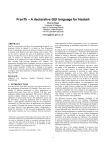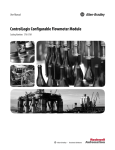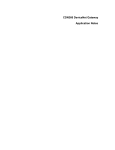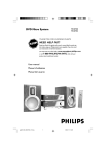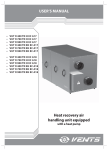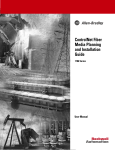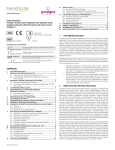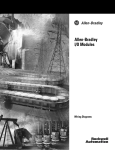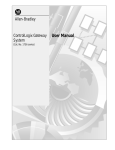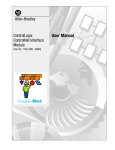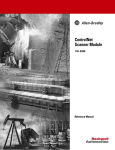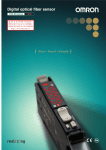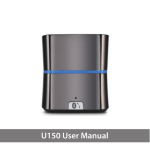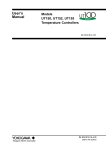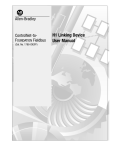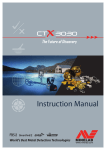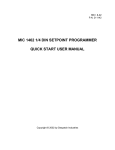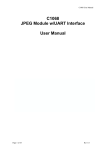Download 1746-UM010, Barrel Temperature Control Module User Manual
Transcript
Barrel Temperature Control Module 1746-BTM User Manual ii Important User Information Because of the variety of uses for the products described in this publication, those responsible for the application and use of this control equipment must satisfy themselves that all necessary steps have been taken to assure that each application and use meets all performance and safety requirements, including any applicable laws, regulations, codes and standards. The illustrations, charts, sample programs and layout examples shown in this guide are intended solely for purposes of example. Since there are many variables and requirements associated with any particular installation, Allen-Bradley does not assume responsibility or liability (to include intellectual property liability) for actual use based upon the examples shown in this publication. Allen-Bradley publication SGI-1.1, Safety Guidelines for the Application, Installation and Maintenance of Solid-State Control (available from your local Allen-Bradley office), describes some important differences between solid-state equipment and electromechanical devices that should be taken into consideration when applying products such as those described in this publication. Reproduction of the contents of this copyrighted publication, in whole or part, without written permission of Rockwell Automation, is prohibited. Throughout this manual we use notes to make you aware of safety considerations: ATTENTION ! Identifies information about practices or circumstances that can lead to personal injury or death, property damage or economic loss Attention statements help you to: • identify a hazard • avoid a hazard • recognize the consequences IMPORTANT Identifies information that is critical for successful application and understanding of the product. Allen-Bradley is a trademark of Rockwell Automation Publication 1746-UM010B-EN-P - April 2001 iii European Communities (EC) Directive Compliance If this product has the CE mark it is approved for installation within the European Union and EEA regions. It has been designed and tested to meet the following directives. EMC Directive This product is tested to meet the Council Directive 89/336/EC Electromagnetic Compatibility (EMC) by applying the following standards, in whole or in part, documented in a technical construction file: • EN 50081-2 EMC — Generic Emission Standard, Part 2 — Industrial Environment • EN 50082-2 EMC — Generic Immunity Standard, Part 2 — Industrial Environment This product is intended for use in an industrial environment. Low Voltage Directive This product is tested to meet Council Directive 73/23/EEC Low Voltage, by applying the safety requirements of EN 61131-2 Programmable Controllers, Part 2 - Equipment Requirements and Tests. For specific information required by EN 61131-2, see the appropriate sections in this publication, as well as the Allen-Bradley publication Industrial Automation Wiring and Grounding Guidelines, publication 1770-4.1. This equipment is classified as open equipment and must be mounted in an enclosure during operation to provide safety protection. Publication 1746-UM010B-EN-P - April 2001 iv Publication 1746-UM010B-EN-P - April 2001 Summary of Changes Major changes in this revision include: • Ladder code addresses have been changed. • The sample ladder code in Chapter 9 has been enhanced. • Examples outlining the mathematical relationships involved in Startup Aggressiveness Factor and Ramp Rates have been included in Chapter 3. • Appendixes A and B have been omitted. • Module specifications can be found in the 1746-BTM Installation Instructions, Publication 1746-IN014B-EN-P. 1 Publication 1746-UM010B-EN-P - April 2001 2 Summary of Changes Publication 1746-UM010B-EN-P - April 2001 Preface Using This Manual This manual shows you how to use the Barrel Temperature Control Module (cat. no. 1746-BTM) in an Allen-Bradley SLC system for barrel temperature control and other injection molding or extrusion related temperature control applications. The manual explains how to install, program, calibrate, and troubleshoot the BTM module. ATTENTION ! Use the 1746-BTM module in a local I/O chassis only for barrel temperature control of injection molding applications or extruders. Any other applications are not supported. Audience You must be able to program and operate an Allen-Bradley SLC programmable controller to make efficient use of this module. In particular, you must know how to configure M0 and M1 files. For more information, see the appropriate SLC programming manual before you generate a program for this module. System Compatibility System compatibility involves data table use as well as compatibility with a local I/O chassis and SLC processor. Data Table Communication between the module and processor is bi-directional. The processor transfers output data through the output image table to the BTM module and transfers input data from the BTM module through the input image table. The BTM module also requires M files for configuration and calibration values. I/O Chassis You can use this module with 1746-A4, -A7, -A10, -or -A13 chassis, provided there is an SLC controller in the chassis (local system). You can place the BTM module in any I/O slot except for the first slot which is reserved for the processor. 1 Publication 1746-UM010B-EN-P - April 2001 P-2 Preface SLC Processor The 1746-BTM module is compatible with any SLC processor that supports M0/M1 files, such as the SLC 5/05, SLC 5/04, SLC 5/03, and SLC 5/02 controllers. Vocabulary In this manual, we refer to: • the barrel temperature control module as the “1746-BTM module,” the “BTM module,” or as “the module” • the programmable controller as the “SLC processor”, or “the processor” • a thermocouple as a “TC” • a time-proportioned output as “TPO” • the tuning-assisted processes as “TAP” • proportional-integral-derivative as “PID” • cold-junction compensation as “CJC” Publication 1746-UM010B-EN-P - April 2001 Table of Contents Important User Information . . . . . . . . . . . . . . . . . . European Communities (EC) Directive Compliance EMC Directive . . . . . . . . . . . . . . . . . . . . . . . . . Low Voltage Directive . . . . . . . . . . . . . . . . . . . Using This Manual . . . . . . . . . . . . . . . . . . . . . . . . Audience . . . . . . . . . . . . . . . . . . . . . . . . . . . . . System Compatibility . . . . . . . . . . . . . . . . . . . . Vocabulary . . . . . . . . . . . . . . . . . . . . . . . . . . . . . . . . . . . . . . . . . . . . . . . . . . . . . . . . . . . . . . . . . . . . . . . . . . . . . . . . . . . ii iii iii iii P-1 P-1 P-1 P-2 Temperature Control Using a BTM Module in an SLC System Features of the Temperature Control Module . . . . . . . . . . . Module Outputs . . . . . . . . . . . . . . . . . . . . . . . . . . . . . . . . Current CV . . . . . . . . . . . . . . . . . . . . . . . . . . . . . . . . . TPO . . . . . . . . . . . . . . . . . . . . . . . . . . . . . . . . . . . . . . Module Addressing . . . . . . . . . . . . . . . . . . . . . . . . . . . . . . Response to Slot Disabling . . . . . . . . . . . . . . . . . . . . . . . . Input response. . . . . . . . . . . . . . . . . . . . . . . . . . . . . . . Output response . . . . . . . . . . . . . . . . . . . . . . . . . . . . . 1-1 1-2 1-2 1-2 1-2 1-4 1-4 1-4 1-4 Chapter 1 Chapter 2 Avoiding Electrostatic Damage. . . . . . . . . . . . . . . . European Communities (EC) Directive Compliance EMC Directive . . . . . . . . . . . . . . . . . . . . . . . . . Low Voltage Directive . . . . . . . . . . . . . . . . . . . Determining Power Requirements . . . . . . . . . . . . . Choosing a Module Slot in a Local I/O Chassis. . . . Installation considerations . . . . . . . . . . . . . . . . Installing the Module. . . . . . . . . . . . . . . . . . . . . . . Removing the terminal block . . . . . . . . . . . . . . Wiring the Module . . . . . . . . . . . . . . . . . . . . . . . . Cold Junction Compensation (CJC) . . . . . . . . . . Wiring considerations. . . . . . . . . . . . . . . . . . . . Preparing and Wiring the Cables . . . . . . . . . . . Specifications. . . . . . . . . . . . . . . . . . . . . . . . . . . . . . . . . . . . . . . . . . . . . . . . . . . . . . . . . . . . . . . . . . . . . . . . . . . . . . . . . . . . . . . . . . . . . . . . . . . . . . . . . . . . . . 2-1 2-2 2-2 2-2 2-3 2-3 2-3 2-4 2-5 2-6 2-6 2-7 2-8 2-10 . . . . . . . . . . . . . . . . . . . . . . . . . . . . . . . . . . . . . . . . . . . . . . . . . . . . . . . . . . . . 3-1 3-1 3-1 3-1 3-2 3-2 3-2 3-2 3-2 3-2 Chapter 3 Loop Operation Mode . . . . . . . . . . . . . . . Word 1, Bits 0 and 1 for Channel 1. . . Type of Loop Input. . . . . . . . . . . . . . . . . Word 1, Bits 2-5 for Channel 1 . . . . . . Enable Loop Alarms . . . . . . . . . . . . . . . . Word 1, Bit 6 for Channel 1 . . . . . . . . TC Break Response . . . . . . . . . . . . . . . . . Word 1, Bits 7 and 8 for Channel 1. . . Loop Autotune Gains Level . . . . . . . . . . . Word 1, Bits 10 and 11 for Channel 1 . 1 . . . . . . . . . . . . . . . . . . . . . . . . . . . . . . . . . . . . . . . . . . . . . . . . . . . . . . . . . . . . . . . . . . . . . . Publication 1746-UM010B-EN-P - April 2001 TOC-2 Table of Contents Barrel/Non-barrel Control . . . . . . . . . . . . . . . . . . . Word 1, Bit 12 for Channel 1 . . . . . . . . . . . . . . Barrel Control . . . . . . . . . . . . . . . . . . . . . . . . . Non–barrel control. . . . . . . . . . . . . . . . . . . . . . Switching the barrel control . . . . . . . . . . . . . . . Inner/Outer Zone Selection . . . . . . . . . . . . . . . . . . Word 1, Bit 13 for Channel 1 . . . . . . . . . . . . . . High/Low CV Limits . . . . . . . . . . . . . . . . . . . . . . . Words 2 and 3 for Channel 1 . . . . . . . . . . . . . . TC Break Control . . . . . . . . . . . . . . . . . . . . . . . . . Word 4 or O:e.8 for Channel1 . . . . . . . . . . . . . Standby Setpoint . . . . . . . . . . . . . . . . . . . . . . . . . . Word 5 for Channel 1 . . . . . . . . . . . . . . . . . . . Heat/Cool Minimum On-times . . . . . . . . . . . . . . . . Words 6 and 8 for channel 1 . . . . . . . . . . . . . . Heat/Cool TPO Period . . . . . . . . . . . . . . . . . . . . . Words 7 and 9 for Channel 1 . . . . . . . . . . . . . . PV Rate and Associated Alarm . . . . . . . . . . . . . . . . Word 10 and Alarm Bit I:e.4/05 for Channel 1. . High/Low Temperature and Deviation Alarms . . . . Words 11-14 for Channel 1. . . . . . . . . . . . . . . . Alarm Dead Band . . . . . . . . . . . . . . . . . . . . . . . . . Word 15 for Channel 1. . . . . . . . . . . . . . . . . . . Thermal Integrity Loss Detection . . . . . . . . . . . . . . Words 16 and 17 for Channel 1 . . . . . . . . . . . . Ramp Rates. . . . . . . . . . . . . . . . . . . . . . . . . . . . . . Words 18 for Channel 1 . . . . . . . . . . . . . . . . . . Non-barrel Autotune Disturbance Size . . . . . . . . . . Word 20 for Channel 1. . . . . . . . . . . . . . . . . . . Implied Decimal Point . . . . . . . . . . . . . . . . . . . Configuration Block, M1 File, Loops 1-4 N10:0-100 . Startup Aggressiveness factor. . . . . . . . . . . . . . . . . Ramp Rates. . . . . . . . . . . . . . . . . . . . . . . . . . . . . . . . . . . . . . . . . . . . . . . . . . . . . . . . . . . . . . . . . . . . . . . . . . . . . . . . . . . . . . . . . . . . . . . . . . . . . . . . . . . . . . . . . . . . . . . . . . . . . . . . . . . . . . . . . . . . . . . . . . . . . . . . . . . . . . . . . . . . . . . . . . . . . . . . . . . . . . . . . . . . . . . . . . . . . . . . . . . . . . . . . . . . . . . . . . . . . . . . . . . . 3-3 3-3 3-3 3-3 3-3 3-4 3-4 3-5 3-5 3-5 3-5 3-5 3-5 3-6 3-6 3-6 3-6 3-6 3-6 3-6 3-6 3-8 3-8 3-9 3-9 3-9 3-9 3-9 3-9 3-10 3-11 3-11 3-12 Chapter 4 Sequence of Setting PID Gains . . . . . . . . . . . . . . . . . . . . . Autotuning the Loops . . . . . . . . . . . . . . . . . . . . . . . . . . . . Fine-Tuning the Loops . . . . . . . . . . . . . . . . . . . . . . . . . . . Using the PID Equation. . . . . . . . . . . . . . . . . . . . . . . . . . . Entering Autotune/Gains Values with Implied Decimal Point PID Gains/Autotune Block, M0 File for Loops 1–4 . . . . Publication 1746-UM010B-EN-P - April 2001 4-1 4-2 4-3 4-4 4-5 4-6 Table of Contents TOC-3 Chapter 5 Controlling a Loop . . . . . . . . . . . . . . . . . . . . . . . . . . . M1 Configuration File. . . . . . . . . . . . . . . . . . . . . . . Output Image Table. . . . . . . . . . . . . . . . . . . . . . . . Autotune a Loop . . . . . . . . . . . . . . . . . . . . . . . . . . . . . Requirements for Autotune. . . . . . . . . . . . . . . . . . . Items to check before autotune . . . . . . . . . . . . . . . Autotune barrel control applications . . . . . . . . . . . . Example: Autotune non–barrel control applications. Troubleshooting Autotune . . . . . . . . . . . . . . . . . . . Using the Output Image Table. . . . . . . . . . . . . . . . . . . Global Commands to All Loops . . . . . . . . . . . . . . . BTM Auto Tune . . . . . . . . . . . . . . . . . . . . . . . . . . . . . . . . . . . . . . . . . . . . . . . . . . . . . . . . . . . . . . . . . 5-1 5-1 5-1 5-2 5-2 5-4 5-4 5-7 5-7 5-8 5-9 5-10 Chapter 6 Input Image Table. . . . . . . . . . . . . . . . . . . . . . . . . . . . . . . 6-1 Implied Decimal Point . . . . . . . . . . . . . . . . . . . . . . . . . 6-1 Chapter 7 About the Procedure . . . . . . . . . . . . . . . . . . . . . . . . . . . . . 7-1 Calibration Codes and Status . . . . . . . . . . . . . . . . . . . . 7-1 Calibration Procedure. . . . . . . . . . . . . . . . . . . . . . . . . . 7-2 Chapter 8 Troubleshooting with LED Indicators . . . . . . . . . . . . . . . . . 8-1 Locating Error Code Information . . . . . . . . . . . . . . . . . . . . 8-2 Chapter 9 Obtaining the Sample Program from the Internet . To Access the Internet:. . . . . . . . . . . . . . . . . . RSLogix500 Version. . . . . . . . . . . . . . . . . . . . . . . BTM Firmware Revision . . . . . . . . . . . . . . . . . . . Support for 5/03, 5/04, 5/04P, 5/05, and 5/05P Processors Using BTM201.rss . . . . . . . . . . . BTM201.rss Data Table Layout . . . . . . . . . . . . Download and Upload Settings . . . . . . . . . . . BTM201.rss Programming Notes . . . . . . . . . . . Support for 5/02 Processors Using BTM50220.RSS BTM50220.RSS Data table layout. . . . . . . . . . . Download and Upload Settings . . . . . . . . . . . General Notes for Programming the 1746-BTM. . . . . . . . . . . . . . . . . . . . . . . . . . . . . . . 9-1 9-1 9-1 9-1 . . . . . . . . . . . . . . . . . . . . . . . . . . . . . . . . . . . . . . . . . . . . . . . . . . . . . . . . 9-1 9-2 9-3 9-5 9-7 9-7 9-7 9-9 Publication 1746-UM010B-EN-P - April 2001 TOC-4 Table of Contents Publication 1746-UM010B-EN-P - April 2001 Chapter 1 Getting Started This chapter gives you information on: • • • • • the function of the temperature control module features of the temperature control module time–proportioned output (TPO) module addressing response to slot disabling ATTENTION ! Temperature Control Using a BTM Module in an SLC System Use the 1746–BTM module only for barrel temperature control for injection molding applications or extruders in a local I/O chassis. Any other applications are not supported. The temperature control module is an intelligent I/O module that can provide a maximum of 4 PID loops for temperature control. The module has 4 analog thermocouple (TC) inputs. Each analog input functions as the process variable (PV) for a PID loop. The PID algorithm and tuning–assisted–process (TAP) algorithm are performed on the module for each of the loops. The control–variable (CV) output of each loop, either analog output or time–proportioned output (TPO), is sent from the module to the SLC data table. Your application ladder logic must access the CV value in the data table and send the analog or TPO data to an output module to close the loop. Figure 1.1 A 1746–BTM module with 4 PID logic channels, showing one complete PID loop SLC data table output module analog or TPO CV CV heater process to be controlled CV CV 1 loop logic PV CV loop logic PV CV loop logic PV CV loop logic PV TC Publication 1746-UM010B-EN-P - April 2001 1-2 Getting Started Features of the Temperature Control Module The 1746–BTM module provides: Module Outputs The BTM module sends the control variable (CV) for heating and/or cooling each loop to the SLC processor’s input image table as both of: • 4 independent temperature control loops • autotune PID loops (one loop or any combination of loops can be autotuned while other loops are running) • a unique start–up algorithm to minimize overshoot • an isolated thermocouple (J and K) input for each PID loop • 16–bit analog–to–digital converter resolution (0.1° resolution) • a heat CV signal (for each PID loop) as a numeric % value • a cool CV signal (for each PID loop) as a numeric % value • a heat CV signal (for each PID loop) as a TPO bit • a cool CV signal (for each PID loop) as a TPO bit • temperature values in C ° or F ° • self–calibration (external reference required) • user–selectable high and low alarms with dead band for hysteresis • input open–circuit detection • numeric value (current CV) • time–proportioned output (TPO) Current CV Your ladder logic should read the numeric value (current CV), scale it, and send it to an analog output module to generate the control signal to an analog temperature control actuator. If using the sample program look for current CVs in N10:208–211 for loops 1–4. Refer to Sample Program on page 9-1. TPO The module returns the heat TPO (bit 6) and cool TPO (bit 7) in input image table words 8–11 for loops 1–4. The sample program sends TPO signals to a digital output module to generate the control signal to a digital temperature control actuator. Refer to Sample Program on page 9-1. Publication 1746-UM010B-EN-P - April 2001 Getting Started 1-3 Figure 1.2 TPO timing diagram CV% = (40%) X = on time (2.0 sec) Y = TPO period (5.00 sec) Y X On data in parenthesis refers to sample program values. TPO bit Off The TPO duty cycle (Y) must be considerable shorter in time than the system dead time. For additional information, Refer to Autotune a Loop on page 5-2. The following memory map shows you how the SLC processor’s output and input image tables are defined for the module. See Table 9.A: BTM201.rss N7 Data Table on page 9-2. Slot e portion of SLC image table for BTM module SLC 5/0x I/O Image Table Output Image BTM Module output image 16 words Slot e See Figure 1.3 on page 1-4 Input Image Slot e See Figure 1.3 on page 1-4 input image 16 words Bit 15 Bit 0 Address Loop 1 configuration data word 0 O:e.0 Loop 2 configuration data word 1 O:e.1 Loop 3 configuration data word 2 O:e.2 Loop 4 configuration data word 3 O:e.3 Loop 1 run setpoint value word 4 O:e.4 Loop 2 run setpoint value word 5 O:e.5 Loop 3 run setpoint value word 6 O:e.6 Loop 4 run setpoint value word 7 O:e.7 Loop 1 manual output value word 8 O:e.8 Loop 2 manual output value word 9 O:e.9 Loop 3 manual output value word 10 O:e.10 Loop 4 manual output value word 11 O:e.11 miscellaneous control bits word 12 O:e.12 not used word 13 O:e.13 not used word 14 O:e.14 not used word 15 O:e.15 Loop 1 temperature word 0 I:e.0 Loop 2 temperature word 1 I:e.1 Loop 3 temperature word 2 I:e.2 Loop 4 temperature word 3 I:e.3 Loop 1 configuration status word 4 I:e.4 Loop 2 configuration status word 5 I:e.5 Loop 3 configuration status word 6 I:e.6 Loop 4 configuration status word 7 I:e.7 Loop 1 control status and TPO word 8 I:e.8 Loop 2 control status and TPO word 9 I:e.9 Loop 3 control status and TPO word 10 I:e.10 Loop 4 control status and TPO word 11 I:e.11 If using the sample program, word 12 variables in words 12-15, including word 13 current CVs, are multiplexed and word 14 scanned into N10:200-243 I:e.12 word 15 I:e.15 I:e.13 I:e.14 Publication 1746-UM010B-EN-P - April 2001 1-4 Getting Started Module Addressing When you enter the module ID in processor configuration (off-line), the processor automatically reserves the required number of I/O image table words. In the figure below, that section of the I/O image table is designated by “slot e”. Its location in the I/O image table is determined by the module’s slot location “e” in the I/O chassis. Slot location “e” is a required addressing unit when referring to the module in ladder logic. For the sample program’s data table layout, See Table 9.A: BTM201.rss N7 Data Table on page 9-2. See Figure 1.3 for an explanation of the image table addresses Figure 1.3 . Input Image Table Address slot Output Image Table Address slot word file type word file type I:e.6 element delimiter O:e.6 word delimiter Response to Slot Disabling element delimiter word delimiter By writing to the status file in your modular SLC processor you can disable any chassis slot. See your SLC programming manual for the slot disable/enable procedure. ATTENTION ! Always understand the implications of disabling the module before using the slot disable feature. Input response When the slot for this module is disabled, the module continues to update its inputs. However, the SLC processor does not read from a module whose slot is disabled. Therefore, inputs appearing in the processor image table remain in their last state, and the module’s updated inputs are not read. When the processor re–enables the module slot, the current state of module inputs are read by the controller during the subsequent scan. Output response When the slot for this module is disabled, configuration words in the SLC processor’s output image table are held in their last state and not transferred to the module. When the slot is re–enabled, output image table words are transferred to the module during the subsequent scan. Publication 1746-UM010B-EN-P - April 2001 Chapter 2 Installing and Wiring This document gives you information about: • • • • • • • Avoiding Electrostatic Damage avoiding electrostatic damage compliance with European Union directive determining the module’s chassis power requirement planning for sufficient enclosure depth choosing a module slot in a local I/O chassis installing the module wiring the module Electrostatic discharge can damage semiconductor devices inside this module if you touch backplane connector pins. Guard against electrostatic damage by observing the following precautions: ATTENTION ! Electrostatic discharge can degrade performance or cause permanent damage. Handle the module as stated below. • Touch a grounded object to rid yourself of charge before handling. • Wear an approved wrist strap when handling the module. • Handle the module from the front, away from the backplane connector. • Do not touch backplane connector pins. 1 Publication 1746-UM010B-EN-P - April 2001 2-2 Installing and Wiring European Communities (EC) Directive Compliance If this product has the CE mark it is approved for installation within the European Union and EEA regions. It has been designed and tested to meet the following directives. EMC Directive This product is tested to meet the Council Directive 89/336/EC Electromagnetic Compatibility (EMC) by applying the following standards, in whole or in part, documented in a technical construction file: • EN 50081-2 EMC — Generic Emission Standard, Part 2 — Industrial Environment • EN 5001082-2 EMC — Generic Immunity Standard, Part 2 — Industrial Environment This product is intended for use in an industrial environment. Low Voltage Directive This product is tested to meet Council Directive 73/23/EC Low Voltage, by applying the safety requirements of EN 61131-2 Programmable Controllers, Part 2 - Equipment Requirements and Tests. For specific information required by EN 61131-2, see the appropriate sections in this publication, as well as the Allen-Bradley publication Industrial Automation Wiring and Grounding Guidelines, publication 1770-4.1. This equipment is classified as open equipment and must be mounted in an enclosure during operation to provide safety protection. Publication 1746-UM010B-EN-P - April 2001 Installing and Wiring Determining Power Requirements 2-3 When computing power supply requirements, add the values shown in Table 2.A to the requirements of all other modules in the SLC chassis to prevent overloading the chassis power supply. Table 2.A Power Supply Requirements Choosing a Module Slot in a Local I/O Chassis 5V dc amps 24V dc amps 0.110 0.085 Place your module in any slot of an SLC500 module, or modular expansion chassis, except for the left–most slot (slot 0), reserved for the SLC processor or adapter modules. IMPORTANT For proper operation, use this module with a local processor. The module is not designed to operate in a remote chassis. Installation considerations Most thermocouple–type applications require an industrial enclosure to reduce the effects of electrical interference. Thermocouple inputs are highly susceptible to electrical noises due to the small signal amplitudes (microvolt/C °). Isolate them from other input wiring and modules that radiate electrical interference. Group your modules within the I/O chassis to minimize adverse effects from radiated electrical noise and heat. Consider the following conditions when selecting a slot location. Position the module away from modules that: • connect to sources of electrical noise such as relays and ac motor drives • generate significant heat, such as 32–point I/O modules Publication 1746-UM010B-EN-P - April 2001 2-4 Installing and Wiring Installing the Module Follow this procedure: ATTENTION ! Never install, remove, or wire modules with power applied to the chassis or devices wired to the module. 1. Align the circuit board of the thermocouple module with the card guides located at the top and bottom of the chassis. 2. Slide the module into the chassis until both top and bottom retaining clips are secured. Apply firm even pressure on the module to attach it to its backplane connector. Never force the module into the slot. 3. Cover unused slots with the card slot filler, catalog number 1746–N2. 4. To remove, press the releases at the top and bottom of the module, and slide the module out of the chassis slot. card guides top and bottom releases retaining clips Publication 1746-UM010B-EN-P - April 2001 Installing and Wiring 2-5 Removing the terminal block When installing the module, it is not necessary to remove the terminal block. But if you need to remove it, follow this procedure: 1. Alternately loosen the two retaining screws to avoid cracking the terminal block. 2. Grasp the terminal block at the top and bottom and pull outward and down. When removing or installing the terminal block be careful not to damage the CJC sensors. Tip: The Replacement Part Number for the Terminal Block with the CJCs is 1746-RT32. You cannot purchase a CJC by itself. CJC sensors retaining screws 3. Use the write–on label to identify the module and its location. SLOT RACK MODULE Publication 1746-UM010B-EN-P - April 2001 2-6 Installing and Wiring Wiring the Module The module has an 18–position, removable terminal block. The terminal block pin–out is shown below. ATTENTION Disconnect power to the SLC before attempting to install, remove, or wire the removable terminal wiring block. ! Figure 2.1 Terminal block pin out. Retaining Screw CJC A+ CJC Assembly Channel 0+ CJC A- Channel 0Channel 1+ Channel 1- Do NOT use these connections Channel 2+ Channel 2Channel 3+ CJC B+ CJC Assembly CJC BRetaining Screw n/c Channel 3spare part catalog number: 1746-RT32 Cold Junction Compensation (CJC) ATTENTION ! Do not remove or loosen the cold junction compensating thermistors located on the terminal block. Both thermistors are critical to ensure accurate thermocouple input readings at each channel. The module will not operate in the thermocouple mode if a thermistor is removed In case of accidental removal of one or both thermistors, replace them by connecting them across the CJC terminals located at the top and/or bottom left side of the terminal block. Always connect the red lug to the (+) terminal (to CJC A+ or CJC B+). Publication 1746-UM010B-EN-P - April 2001 Installing and Wiring 2-7 Figure 2.2 Thermistor placement on the bottom of the terminal block Always attach red lug to the CJC+ terminal Wiring considerations Follow the guidelines below when planning your system wiring. • To limit the pickup of electrical noise, keep thermocouple and millivolt signal wires away from power and load lines. • For high immunity to electrical noise, use Alpha 5121 (shielded, twisted pair) or equivalent wire for millivolt sensors; or use shielded, twisted pair thermocouple extension lead wire specified by the thermocouple manufacturer. Using the incorrect type of thermocouple extension wire or not following the correct polarity may cause invalid readings. See IEEE Std. 518, Section 6.4.2.7 or contact your sensor manufacturer for additional details. • When trimming cable leads, minimize the length of unshielded wires. • Ground the shield drain wire at only one end of the cable. The preferred location is at the I/O chassis ground (See Figure 2.4). • For maximum noise reduction, use 3/8 inch braid wire to connect cable shields to the nearest I/O chassis mounting bolt. Then connect the I/O chassis to earth ground (See Figure 2.4). These connections are a requirement regardless of cable type. • Tighten terminal screws. Excessive tightening can strip the screw. • The open–circuit detector generates approximately 20 nano– amperes into the thermocouple cable. A total lead resistance of 25 ohms (12.5 one–way) will produce 0.5 mV of error. • Follow system grounding and wiring guidelines found in your SLC 500 Modular Hardware Installation and Operation Manual, publication 1747–6.2. Publication 1746-UM010B-EN-P - April 2001 2-8 Installing and Wiring Preparing and Wiring the Cables To prepare and connect cable leads and drain wires, follow these steps: Figure 2.3 Cable lead and drain wire preparation Remove the foil shield and drain wire from sensor-end of the cable Signal Wires Extract the drain wire but remove the foil shield, at the module-end of the cable. Drain Wire Signal Wires 1. At each end of the cable, strip some casing to expose individual wires. 2. Trim signal wires to 5–inch lengths beyond the cable casing. Strip about 3/16 inch (4.76 mm) of insulation to expose the ends of the wires. 3. At the module–end of the cables: - extract the drain wire and signal wires - remove the foil shield - bundle the input cables with a cable strap 4. Connect drain wires together and solder them to a 3/8” wire braid, 12” long. Keep drain wires as short as possible. 5. Connect the 3/8” wire braid to the nearest chassis mounting bolt. 6. Connect the signal wires of each channel to the terminal block. Publication 1746-UM010B-EN-P - April 2001 Installing and Wiring 2-9 7. At the source-end of cables from mV devices (See Figure 2.3 and Figure 2.4): • remove the drain wire and foil shield • apply shrink wrap as an option • connect to mV devices keeping the leads short Figure 2.4 Cable Preparation to Minimize Electrical Noise Interference Make unshielded wires as short as possible. Solder drain wires to braid at casing. Wires Terminal Block 3/8” Signal Wires Chnl 0 Connect I/O chassis bolt to earth ground 3/8” Chnl 1 Cables Make unshielded wires as short as possible. Chnl 2 Chnl 3 n/c Limit braid length to 12” or less. Solder braid to lug on bottom row of I/O chassis bolts. IMPORTANT If noise persists, try grounding the opposite end of the cable. Ground one end only. Publication 1746-UM010B-EN-P - April 2001 2-10 Installing and Wiring Specifications Backplane Current consumption 110 mA at 5V dc 85 mA at 24V dc Backplane power consumption 0.6W maximum (0.55W @ 5V dc, 2W @ 24V dc) Number of channels 4 (backplane and channel-to-channel isolated) I/O chassis location any I/O module slot except 0 A/D conversion method sigma-delta modulation Input filtering analog filter with low pass digital filter Normal mode rejection between [+]input and [-]input greater than 50 dB at 50 Hz greater than 60 dB at 60 Hz Common mode rejection between inputs and chassis ground greater than 120 dB at 50/60 Hz with 1K ohm imbalance Channel bandwidth (-3db) 8 Hz Calibration once every six months Isolation 1000V transient or 150 VAC continuous channel-to-channel or channel-to-backplane Agency Certifications When product or packaging is marked: Listed Industrial Control Equipment Certified Process Control Equipment Certified for use in Class I, Division 2, Groups A, B, C, D or nonhazardous locations Marked for all applicable directives Marked for all applicable acts N223 Publication 1746-UM010B-EN-P - April 2001 Chapter 3 Configuring the Module You configure the module by setting words and bits for each loop in Configuration Block, N10:0–100, which your ladder logic uses to load the module’s M1 file. We cover bit selections and word descriptions. Refer to Table 3.B on page 3-13 for selections, units, and defaults. Loop Operation Mode Word 1, Bits 0 and 1 for Channel 1 Use these bits to select how you want the loop to perform: Type of Loop Input Mode of Loop Operation 01 00 monitor the loop to indicate temperature and alarms 0 0 perform PID loop control with temperature indication and alarms 0 1 disable the loop 1 0 invalid setting 1 1 Word 1, Bits 2-5 for Channel 1 Use the following bits to select type J or K thermocouple; any other bit setting is invalid: 1 TC 05 04 03 02 type J 0 0 0 0 type K 0 0 0 1 Publication 1746-UM010B-EN-P - April 2001 3-2 Configuring the Module Enable Loop Alarms Word 1, Bit 6 for Channel 1 Set this bit to enable alarms for the designated loop. TC Break Response Word 1, Bits 7 and 8 for Channel 1 If the module detects a TC open wire for a loop in automatic mode, you can select how the module responds in one of the following ways: TC Break Response 08 07 disables the loop 0 0 forces CV to TC Break Control value (word 4, below) 0 1 forces CV to manual % output (O:e.8 for loop 1) 1 0 invalid setting 1 1 For additional information, Refer to TC Break Control on page 3-5. Loop Autotune Gains Level Word 1, Bits 10 and 11 for Channel 1 You can change and download autotune gains level selection for any or all zones at any time. When changed, you must redownload the M1 file (configuration) followed by the M0 file (autotune/gains) so the module can recalculate PID values based on new loop autotune gains. You do not need to re–autotune. Publication 1746-UM010B-EN-P - April 2001 Autotune Gain Level 11 10 low 0 0 medium 0 1 high 1 0 very high 1 1 Configuring the Module Barrel/Non-barrel Control 3-3 Word 1, Bit 12 for Channel 1 You select between barrel and non–barrel control. Select: for these applications: 12 barrel control heat–only or heat/cool 0 non–barrel control heat–only, cool–only, or heat/cool 1 Barrel Control Select barrel control for multiple–zone applications in which there is thermal conduction between the zones. Injection molding and extrusion are good example applications because they use multiple heater bands (zones) mounted on one thermal conductor (the metal barrel). The barrel conducts heat between different zones. If you select barrel control, also select between inner and outer zones (word 1, bit 13 for channel 1). A barrel loop is autotuned as the temperature rises from a cold start to a temperature setpoint during startup. Non–barrel control Select non–barrel control for applications with independent loops and no thermal conduction between zones. If you select non–barrel control, the inner/outer zone selection doesn’t apply. Switching the barrel control For some applications, even though the loops are independent with no thermal conduction between zones, barrel control might provide better performance than non–barrel control. If a loop has any of these characteristics, you might want to use barrel control if the: • time constant is greater than 10 - 30 seconds • loop has a problem of overshooting the setpoint • loop output is saturating (CV is at 100%) for a significant duration Publication 1746-UM010B-EN-P - April 2001 3-4 Configuring the Module ATTENTION If you switch a loop between non–barrel and barrel control, you must re–autotune the loop before operating it. If you don’t re–autotune, the autotune values will be wrong for the application and the gains will be greatly distorted. ! Inner/Outer Zone Selection Word 1, Bit 13 for Channel 1 If you make a selection for barrel control, you also must select whether the loop is an inner zone or outer zone. Select: for a zone: 13 inner not at either end of the barrel 0 outer at either end of the barrel 1 The PID gain calculation algorithm for an inner zone is slightly different than that for an outer zone to account for an inner zone being more affected by adjacent zones. The inner zones are treated as more of an integrating process than the outer zones. Typical plastic injection barrel Outer with multiple temperature zones Zone Nozzle Hn Inner Zone Zone 1 H1 Inner Zone Outer Zone Zone 2 H2 Zone 3 H3 Ram (Screw) Ts Tn T1 T2 T3 T = temperature measurement point (thermocouple) H = heater band (element) Tf If you change the inner/outer zone selection after autotune, you must re–autotune. Publication 1746-UM010B-EN-P - April 2001 Configuring the Module High/Low CV Limits 3-5 Words 2 and 3 for Channel 1 Use CV High and Low Limits to set up the loop mode: TC Break Control For this loop mode: CV Low: CV High: heat, only 0% 100% cool, only -100% 0 heat/cool -100% +100% Word 4 or O:e.8 for Channel1 If a loop input circuit becomes open (open wire) the loop can not measure temperature. In automatic mode, the lack of temperature feedback makes it impossible to control the temperature. To guard against this condition, the BTM module provides TC break detection. When a break is detected, the module responds in one of these ways: • disables the loop • forces CV to this (TC Break Control) value (word 4 for loop 1) • forces the CV to the manual %–output value (O:e.8 for loop 1) Once the thermocouple break has been repaired you must disable the loop and then re-enable it (through the input image table O:e.0/0 loop 1). For additional information, Refer to TC Break Response on page 3-2. Standby Setpoint Word 5 for Channel 1 When not using the runtime setpoint (O:e.4 for loop 1), use this value to hold a lower temperature for faster warm up and/or optimum standby conditions. Publication 1746-UM010B-EN-P - April 2001 3-6 Configuring the Module Heat/Cool Minimum On-times Words 6 and 8 for channel 1 These values determine the minimum cycle time after which loop TPO bits will turn ON. They are used to allow contactors time to close or pull in. If the contactor is energized for less than this value, the contactor will not close, but the attempt will count as a cycle. For example, suppose you set the TPO period for 10 seconds and the minimum ON time to 1 second. Then if the module calculates a CV% of 10% or less, the TPO bit for that zone will not turn ON. Heat/Cool TPO Period Words 7 and 9 for Channel 1 When CV loop output is time–proportioned (TPO), use this value to set the interval between successive turn–ONs. For less than a 100% output level, the output goes OFF for the balance of the interval. PV Rate and Associated Alarm Word 10 and Alarm Bit I:e.4/05 for Channel 1 The PV Rate is a setpoint with an associated alarm that indicates when the temperature is rising too rapidly. If the zone’s PV has risen more than this setpoint in one second (in auto mode), the module sets the PV rate alarm bit (I:e.4/05, loop 1). The module only reports this alarm - no action is taken. High/Low Temperature and Words 11-14 for Channel 1 Deviation Alarms In the configuration block (M1 file) you select values for the following temperature–level alarms: • • • • Publication 1746-UM010B-EN-P - April 2001 low temperature alarm (word 11 for channel 1) high temperature alarm (word 12 for channel 1) low deviation alarm from the set point(word 13 for channel 1) high deviation alarm from the set point(word 14 for channel 1) Configuring the Module Temp 3-7 High Temperature Alarm Value (absolute) High Deviation Alarm Value (track setpoint) Set Point Low Deviation Alarm Value (track setpoint) 0° Low Temperature Alarm Value (absolute) Time Publication 1746-UM010B-EN-P - April 2001 3-8 Configuring the Module Alarm Dead Band Word 15 for Channel 1 Once the temperature alarm bits are on, they remain on until the temperature drops below the high alarm by the alarm dead–band value or rises above the low alarm by this value. The alarm dead band applies to the CV value at the high and low temperature alarms and deviation alarm values and provides a hysteresis effect. Low and high alarms are defined as: • Low Alarm With Dead Band — When the temperature falls below the user–defined low alarm value, the low alarm bit is turned on. When the temperature rises above the level of the low alarm value but still below the level of the dead–band value, the low alarm bit remains on. Only when the temperature rises above the dead–band level will the alarm bit be turned off. • High Alarm With Dead Band — When the temperature rises above the user–defined high alarm value, the high alarm bit is turned on. When the temperature falls below the level of the high alarm value but still above the level of the dead–band value, the high alarm bit remains on. Only when the temperature falls below the dead–band level will the alarm bit be turned off. low (CV) alarm level D e a d b a n d Temperature high (CV) alarm level D e a d b a n d Time alarm off alarm on Publication 1746-UM010B-EN-P - April 2001 Configuring the Module Thermal Integrity Loss Detection 3-9 Words 16 and 17 for Channel 1 The loss of thermal integrity is detected when the loop, in automatic mode, is not responding to a CV at 100% Detecting the loss of thermal integrity requires an assumption of a minimum rate of change in the temperature (PV) when the output (CV) is at 100%. Examples of a loss of thermal integrity could be the failure of a heating–band contactor to close, or a sensor not in proper position to measure true temperature. The values you enter in words 16 and 17 for loop 1 establish a minimum rate of change (°/min.) in the temperature input (PV) that you allow when the output (CV) is at 100% in automatic mode. The temperature change value you enter in word 16 divided by the period value you enter in word 17 is the thermal integrity rate. IMPORTANT Ramp Rates Once loss of thermal integrity is detected, you must clear this condition by disabling the affected loop and then re–enabling it. To disable this feature, enter zero in for both setpoints. Words 18 for Channel 1 This value ramps the setpoint in steps to the new setpoint. Non-barrel Autotune Disturbance Size Word 20 for Channel 1 This is a pure %–output step function for performing a non-barrel autotune. It is added to the current output (%). It should be applied under steady–state conditions. The loop operating mode must be non–barrel. EXAMPLE Consider this: • CV is 10% • non-barrel Autotune Disturbance Size is 10% If an autotune is invoked the CV’s output would go to 20% for the duration of the Autotune. Publication 1746-UM010B-EN-P - April 2001 3-10 Configuring the Module IMPORTANT Because loop values are stored and reported in integer files, you must understand the meaning of implied decimal point (IDP). Otherwise, the magnitude of your intended value may be in error by as much as 1000, depending on the position of the IDP. Implied Decimal Point When entering or reading integer values, the range, given in Table 3.A, provides the implied decimal point. It is the number of digits to the right of the decimal point (for an example (IDP) range of 0.0 thru 3276.7, the implied decimal point is 1). Status values are similarly read. You must know the range of the value to read it correctly. For example, if reading a heat integral (0.0000 thru 3.2767), a display of 5000 would have a value of 0.5. Table 3.A Implied Decimal Point Examples Example Parameter Given Range Thermal Integrity 0 thru 100o 0 If you want to store a value of 66o, enter 00066. Standby Setpoint 0.0 thru 32767.7o 1 If you want to store a value of 660.0o, enter 06600. TPO Period 0.00 thru 100.00 sec. 2 If you want to store a value of 6 seconds, enter 00600. Cool Proportional 0.000 thru 32.767 3 If you want to store a value of 18, enter 18000. Heat Integral 0.0000 thru 3.2767 4 If you want to store a value of 0.5, enter 05000. (1) IDP(1) IDP indicates the number of digits from the right that locates the implied decimal point. Publication 1746-UM010B-EN-P - April 2001 Configuring the Module 3-11 Configuration Block, M1 File, Loops 1-4 N10:0-100 Configuration block (M1 file) contains 101 words as listed below. Data table location for Loops 1-4 are located in N10. For each additional 1746-BTM, add 1 to N10 (N11:0-100). Startup Aggressiveness factor The startup aggressiveness factor (SAF) modifies the pre-set point value. The pre-set point value is the temperature at which you switch from the cold startup algorithms to PID control. The pre-set point value is calculated from the auto tune data. The value is returned through the rotator bits. In the example code it would be found in Nxx:236 thru 239, a value for each channel. The startup aggressiveness factor increases the pre-set point value by percentage. For example: EXAMPLE Consider: • setpoint is 400.0° • preset point for channel 1 (nxx:236) is 75° • startup aggressiveness factor is 0% The point at which you would switch from the cold startup algorithm to PID control would be: SAF setpoint – 1 – ----------- × presetpoint 100 (0) 400.00 – 1 – --------- × 75.0 = 325° 100 If the startup SAF factor is set to 25%, the point at which you would switch from the cold startup algorithms to PID control would be: ( 25 ) 400.00 – 1 – ---------- × 75.0 = 343.8° 100 IMPORTANT The higher the startup aggressiveness factor is, the closer to setpoint you will go before you switch from the cold startup algorithms to PID control. If your pre-set point is too close to the actual setpoint you can expect overshoot to occur. If you change the startup aggressiveness factor you will need to redownload the M1 configuration and the M0 autotune block for the change to take effect. Publication 1746-UM010B-EN-P - April 2001 3-12 Configuring the Module Ramp Rates The ramp rate value modifies the setpoint in steps until it reaches the new setpoint. This value works in conjunction with the ramp enable and ramp hold bits in the output image table for each channel. EXAMPLE The following outlines the relationship between ramp rate, TPO: • • • • • ramp rate 10 °/min. TPO of 10 sec. set point of 300° current temperature of 100° your goal is to ramp to the setpoint, but hold at 200° for 10 minutes; then continue to ramp to set point. To set the ramp enable bit, do the following: 1. Go to the output image table to set the ramp enable bit. 2. A snap shot of the current temperature occurs, which becomes the current setpoint. 3. A calculation is performed to determine the amount the setpoint needs to be raised every TPO period, so every TPO period the setpoint increases 1.67° until the setpoint is reached. 1min ramprate × ------------- × TPO 60 1min 10° ------------- × 10 sec = 1.67° ⁄ TPO period 60 4. Temperature ramps. Ladder logic determines when you reach 200°. When 200° is reached, ladder logic would set the ramp hold bit in the output image table, and ladder logic would start a 10 minute time. 5. When the 10 minute time runs out, the ladder logic would reset the ramp hold bit in the output image table. 6. Ramping of the setpoint would continue until 300° is reached. At that point, ladder logic would determine 300° was met, and it would reset the ramp enable bit. Publication 1746-UM010B-EN-P - April 2001 Configuring the Module 3-13 Table 3.B Block Header (word 0 / N10:0) = 8801 (-30719 decimal) Loops 1-4 Word # 1 1 Set a bit or enter a value 2 3 4 26 51 76 bit 0-1 to Configure operation mode 2-5 input type 6 alarm enable 1 0 Monitor, No PID Control Bit Select or Range 15 14 13 12 11 10 0 0 Control loop with PID 0 1 Disable loop 1 0 9 8 7 6 4 3 2 0 0 0 0 Type K 0 0 0 1 Disable = 0; Enable = 1 X 0 0 TC break configuration Use thermal runaway CV 0 1 Use manual mode CV 1 0 reserved low gains 0 0 medium gains 0 1 high gains 1 0 1 1 10-11 Autotune gains 12 Barrel control Barrel=0;Non-barrel=1 13 Zone Inner=0; Outer=1 14-15 reserved very high gains X X 2 27 52 77 0-15 High CV limit % -100.00 thru +100.00% default = +100.00% 3 28 53 78 0-15 Low CV limit % -100.00 thru +100.00% default = 0.00% 4 29 54 79 0-15 CV for TC break -100.00 thru +100.00% default = 0.0 5 30 55 80 0-15 Standby setpoint 0.0 thru 3276.7° default = 0.0 6 31 56 81 0-15 Heat on time (min.) 0.00 thru 100.00 sec. default = 0.00 7 32 57 82 0-15 Heat TPO period 0.00 thru 100.00 sec. default = 5.00 8 33 58 83 0-15 Cool on time (min.) 0.00 thru 100.00 sec. default = 0.00 9 34 59 84 0-15 Cool TPO period 0.00 thru 100.00 sec. default = 5.00 10 35 60 85 0-15 PV alarm rate -3276.8 thru 3276.7°/s default = 0.0 11 36 61 86 0-15 Low temp alarm -3276.8 thru 3276.7°/s default = +999.9 12 37 62 87 0-15 High temp alarm -3276.8 thru 3276.7°/s default = +999.9 13 38 63 88 0-15 Low deviation -3276.8 thru 3276.7°/s default = +999.9 14 39 64 89 0-15 High deviation -3276.8 thru 3276.7°/s default = +999.9 15 40 65 90 0-15 Alarm dead band 0.0 thru 10.0° 16 41 66 91 0-15 Thermal Integrity Loss 0 thru 100° default = 5 17 42 67 92 0-15 Integrity Rate 0 thru 100 minutes default = 20 18 43 68 93 0-15 ramping 0 thru 100°/min. default = 0 19 44 69 94 reserved 20 45 70 95 0-15 Non-barrel autotune disturb size 0.00-100.00% 21 46 71 96 0-15 Startup aggressiveness factor 0 thru 100 <=25 <=50 <=75 <=99 5 Type J disable PID loop (CV=0) 7-8 9 default = 0.0 default = 10.00 default = 0 for heat or cool, only; 25 for heat/cool reserved Publication 1746-UM010B-EN-P - April 2001 3-14 Configuring the Module Publication 1746-UM010B-EN-P - April 2001 Chapter 4 Setting Autotune and Gains Values This chapter shows you how to independently set the gains for each PID loop of the BTM module. This includes: • • • • • Sequence of Setting PID Gains setting PID gains autotuning the loops fine tuning the loops using the PID equation configuring the autotuning and gains block Any time you successfully autotune the loop, write an autotune block to the module, or write a gains block to the module, a new set of PID gains is established on the module. The following list summarizes the process: • Autotuning causes the module to measure the process dynamics and calculates PID gains. • Reading the PID gains block from the module copies the PID gains generated by autotuning into the SLC files. • Writing the PID gains block to the module overwrites any PID gains that had been in the module. • Autotuning or writing the autotune block to the module causes the module to calculate PID gains and overwrite any PID gains that had been in the module. At initial start–up, you must write the autotune block to the BTM module or perform autotuning. If you select autotuning, for any loop that is successfully tuned, the gains are calculated by the module. Gains you sent to the module for a loop in any gains block previous to successful autotuning of the loop are superseded by the gains derived from autotuning. If you then read the gains block, it contains the gains derived from autotuning. If autotuning is not successful for any loops (as indicated in the status block) the gains you sent for those loops before autotuning is used by the module. 1 Publication 1746-UM010B-EN-P - April 2001 4-2 Setting Autotune and Gains Values Once autotuning is complete, you must read the gains block from the module to store it in SLC processor memory. You can write the autotune and gains block either of these ways: • Send autotune block to the module in words 1-24 (NXX:110-134). This causes the module to calculate the PID gains. In this case, set the block header in word 0 (NXX:110) to 880A hexadecimal. or • Send PID gains only in words 25-48 (NXX:145-168). This overwrites the current PID values in the module. In this case, set the block header in word 0 (NXX:120) to 880B hexadecimal. IMPORTANT When you download either an autotune or gains block, the BTM module’s PID algorithm requires time to adjust, proportional to the thermal mass of the system. This could cause a slow or unexpected system response. The module’s memory is volatile. Whenever power to the module is interrupted, you must establish the gains again. If you don’t send an autotune block, PID block, or both blocks to the module, the module will not work in automode. Sending the autotune block establishes the start–up algorithm and the values the module uses to calculate the PID gains, causing the module to recalculate the PID gains. However, you can override the autotune gains by sending the gains block after the autotune block. IMPORTANT Autotuning the Loops You must initially download M0 and M1 files for the module to operate. You select autotuning from the output image table block (Refer to Using the Output Image Table on page 5-8). For each loop, you must turn on the specific bit to enable autotuning for the corresponding loop. To trigger the start of autotuning, you must also cause a 0–to–1 transition of word 12, bit 1 of the output image table. During autotuning, the module measures system parameters. At the end of autotuning, the module calculates PID gains based on these parameters and your selection of low, medium, or high PID gain level in the configuration block. When autotuning is complete, the PID gains calculated from autotuning are available in the gains block that you can read from the module. Publication 1746-UM010B-EN-P - April 2001 Setting Autotune and Gains Values 4-3 Whenever you write autotune values to the module, it recalculates PID gains based on measured system parameters stored in the autotune block and your selection of low, medium, or high PID gain level stored in the latest configuration block. If you changed the level of PID gains selection in the configuration block in the mean time, the PID gains calculated would be different from those calculated originally. Configuration Block Your selection of PID gains level: • low • medium • high Autotuning Calculations Autotune Block System parameters Fine-Tuning the Loops Gains Block PID gains After autotuning, you may want to fine–tune the loops by manually setting the gains. As you fine–tune a loop, first try adjusting the proportional gain; this will have the greatest impact. Your second choice for adjustment should be the integral gain. The derivative gain should be the last choice for fine–tuning a loop. If the loop over–shoots the set point either at start–up or at a change of set point, (See Figure 4.1) you may be able to dampen the loop response by doing one or more of the following (in order of effectiveness): 1. decrease the proportional gain 2. decrease the integral gain 3. increase the derivative gain Figure 4.1 Loop Over-shoot Set Point Publication 1746-UM010B-EN-P - April 2001 4-4 Setting Autotune and Gains Values If the loop is slow in reaching the set point either at start–up or at a change of set point, (See Figure 4.2) you may be able to improve the loop response by doing one or more of the following (in order of effectiveness): 1. increase the proportional gain 2. increase the integral gain 3. decrease the derivative gain Figure 4.2 Loop Slow to Set Point Set Point Using the PID Equation The module provides dependant PID control action. Dependent control action can be represented by the equation t d-----E- CV = K p E + K i ∫ E ⋅ D t + K z dt 0 Where: CV = Control variable Kp = Proportional gain (no units) E = Error (SP-PV or PV-SP) Ki = Integral gain (repeats/seconds) Kz = Derivative gain (seconds) t = Time The module is capable of performing PID control by calculating the solution to an approximation of the PID equation. The approximation is represented by the equation: t ∆E CV = K p E + K i ∑ E ⋅ ∆ t + K z ------- ∆t 0 Where: t ∑ E ⋅ ∆t = 0 Publication 1746-UM010B-EN-P - April 2001 E 1 ⋅ ∆t + E 2 ⋅ ∆t + E 3 ⋅ ∆t + etc ..... Setting Autotune and Gains Values Entering Autotune/Gains Values with Implied Decimal Point 4-5 The autotune/gains block (M0 file) contains 49 words as listed in Table 4.A below. For each gain value, you enter a 16–bit integer value. IMPORTANT Because loop values are stored and reported in integer files, you must understand the meaning of IDP. Otherwise, the magnitude of your intended value may be in error by as much as 1000, depending on the position of the IDP. When entering or reading integer values, the range, given in the associated table, tells you the implied decimal point. It is the number of digits to the right of the decimal point (for an example range of 0.0 thru 3276.7, the implied decimal point is 1). Table 4.A Autotune/Gains Values with Implied Decimal Point Example Parameter Given Range Cool Time Constant 0.0 thru 32767.7 sec. 1 If you want to store a value of 660.0, enter 06600. Heat Gain 0.00 thru 327.67o/sec. 2 If you want to store a value of 100.00, enter 10000. Cool Proportional 0.000 thru 32.767 3 If you want to store a value of 18, enter 18000. Heat Integral 0.0000 thru 3.2767 4 If you want to store a value of 0.5, enter 05000. (1) IDP(1) IDP indicates the number of digits from the right that locates the implied decimal point. Publication 1746-UM010B-EN-P - April 2001 4-6 Setting Autotune and Gains Values PID Gains/Autotune Block, M0 File for Loops 1–4 IMPORTANT Word numbers for loops 1–4 are in left–most columns. For corresponding NX:xx address, add 110 to word the number. Table 4.B PID Gains/Autotune (N10:110-158): Block Header (word 0 / N10:110) = 880B (-30709 decimal) Loops 1-4 Autotune Values (N10:111-134) 1 2 3 4 1 7 13 19 Heat gain 0.00 thru 327.67°/sec. 2 8 14 20 Heat time constant 0.0 thru 3276.7 sec. 3 9 15 21 Heat dead time 0.0 thru 3276.7 sec. 4 10 16 22 Cool gain 0.00 thru 327.67°/sec. 5 11 17 23 Cool time constant 0.0 thru 3276.7sec 6 12 18 24 Cool dead time 0.0 thru 3276.7 sec. Loops 1-4 1 2 3 To Configure Range PID Gains Values (N10:135-158) 4 To Configure Range 25 31 37 43 Heat proportional 0.000 thru 32.767 26 32 38 44 Heat integral 0.0000 thru 3.2767 rpts/ sec. 27 33 39 45 Heat derivative 0.0 thru 3276.7 sec. 28 34 40 46 Cool proportional 0.000 thru 32.767 29 35 41 47 Cool integral 0.0000 thru 3.2767 rpts/ sec. 30 36 42 48 Cool derivative 0.0 thru 3276.7 sec. Note: Refer to Download and Upload Settings on page 9-3 for download command bits. Publication 1746-UM010B-EN-P - April 2001 Chapter 5 Control and Autotune a Loop This chapter explains how to: • control loop operation • autotune a loop Controlling a Loop At initial start–up, you must write the M1 configuration block to establish the module’s mode of control. Then, you must update the output image table any time you want to change the operating mode. M1 Configuration File You select the loop control mode in the configuration file: Words Bit 01 Bit 00 Lets you select 1, 26, 51, 76 for loops 1-4 0 0 monitor the loop 0 1 control the loop with PID 1 0 disable the loop Output Image Table If you select “control–the–loop” mode, you control loop operation with these words and bits in the output image table (abbreviated list): 1 Words Bit Lets you 0-3 loops 1-4 00 enable or disable the loop 03 enable or disable autotune 4-7 n/a enter run temperature setpoints 8-11 n/a enter manual CV% output values 12 global for all loops 01 invoke autotune 02 abort autotune 03 reset error codes Publication 1746-UM010B-EN-P - April 2001 5-2 Control and Autotune a Loop Figure 5.1 Control Mode Selections and Loop Operation through the M1 configuration block through the output image table Control Mode Selections Disable the Loop Loop Operation Hold CV=0, and no temperature or alarms Monitor the Loop Hold CV=0, but monitor temperature and provide temperature and alarms in the status block Control the Loop Disable Loop Control Enable Loop Control Autotune a Loop Manual Mode The manual output value in the configuration block is used as the CV value Automatic Mode The PID algorithm generates the CV value The BTM module uses the output image table to control loop operation. See Table 5.C on page 5-8 for the listing of words and bits. Operating Commands to Loops 1-4 Use the following as a guide: Requirements for Autotune • Start autotune from a steady–state temperature. For best results, do a cold start. If the temperature fluctuates, autotune may not provide accurate results. • The runtime setpoint for autotune must be at least 50oF (28.7o C) above current temperature or autotune will not start. Publication 1746-UM010B-EN-P - April 2001 Control and Autotune a Loop 5-3 • Set the TPO period smaller than the system dead time. Autotune algorithm may calculate excessive gains if system dead time is less than the TPO period. This may cause the PV to overshoot Figure 5.2 Set TPO Period output (CV) changed system dead time Temperature System dead time should be larger than one TPO period for autotune to work properly 1 TPO period Output (CV) t0 Time • The autotune algorithm does not take the temperature to setpoint. When autotune is complete, the zones will return to the mode (auto or manual) that was selected before autotune. Figure 5.3 Autotune setpoint zones maximum slope Temperature Return to the control mode that was selected before autotune system dead time Time autotune complete Publication 1746-UM010B-EN-P - April 2001 5-4 Control and Autotune a Loop Items to check before autotune Each loop must: • be configured with a valid M1 file and no errors (N10:212-215) • be set for barrel mode • be set in manual mode and that run setpoints are selected, starting from a cold start. If not starting from a cold start, at a steady state temperature. • have the TPO period set considerably smaller than the system dead time. A good place to start is 5 or 10 seconds. • not have any existing alarm conditions that could cause problems (such as a TC break) Autotune barrel control applications Autotune enables the module to compute PID values for optimum temperature control. You must load the program and use the following procedure to autotune the module. For barrel control, better results are achieved when you autotune all loops associated with the barrel at the same time. After autotune, each zone will return to the mode (auto or manual) that was selected beforehand. IMPORTANT Publication 1746-UM010B-EN-P - April 2001 For best results, start from room temperature (cold start). Control and Autotune a Loop 5-5 1. Assume using data table N10 in the following example. Set initial conditions: Table 5.A Configuration File N10 Data Table Example N10:1 bits 00 01 set for PID control N10:26 bits 00 01 set for PID control N10:51 bits 00 01 set for PID control N10:76 bits 00 01 set for PID control remaining bits/words set for your application Table 5.B Data Table Example: Output image buffer table words 180–183 bits 00–03 for loops 1–4. bit 00 1 enables PID control bit 01 0 puts loop into manual mode bit 02 1 uses runtime setpoint bit 03 1 enables autotune • Set to zero Output image buffer table words 188–191 for loops 1–4. • In the sample code, it zeros manual outputs to remove control signals from loops. 2. Download the M1 Configuration File by setting N7:12/00 = 1. 3. Download the M0 Autotune File by setting N7:12/01 = 1. 4. Verify that the M1 Configuration File downloaded: a. Check input image buffer words 164–167 bits 03, 04 for loops 1–4 to verify: • bit 03 = 1 module received a valid M1 file for the loop •bit 04 = 0 no parameter errors for the loop. If bit 04 (parameter error) is set for any loop, look for the error code in N10:212–215. Refer to Locating Error Code Information on page 8-2. b. Check input image buffer words 168–171 bits 00–02 for loops 1–4 to verify that the module: • bit 00 = 1 enabled PID control • bit 01 = 0 put loop into manual mode • bit 02 = 1 used runtime setpoint Publication 1746-UM010B-EN-P - April 2001 5-6 Control and Autotune a Loop 5. Enter runtime temperature setpoints (at least 50oF (28.7oC) above current temperature) into output image buffer words 184– 187 for loops 1–4. IMPORTANT For implied decimal point, enter 2000 for 200o 6. Invoke autotune. (Starts autotune for loops enabled in step 1.) Set output image buffer table word 192, bit 1 = 1. The module needs a 0–1 transition of this bit. 7. Verify autotune is in progress. Monitor input image buffer word 168, bit 11 for a 0–1 transition. 8. Reset the autotune invoke bit. Reset output image buffer table word 192, bit 1 = 0. 9. Enable each loop for automatic mode. This lets each loop control to run setpoint when autotune completes. a. Output image buffer words 160–163 bit 01 for loops 1–4 bit 01 = 1 puts loop into automatic mode 10. Verify that autotune is complete and successful. Input image buffer words 168–171 bits 03 and 04 for loops 1–4 bit 03 = 1 autotune complete bit 04 = 1 autotune successful If bit 04 = 0 (not successful) for any loop, look for the error code in N10:212–215. Refer to Locating Error Code Information on page 8-2. 11. Upload the autotune/PID gains block to the processor for storage. Set word N7:12 = 24. Following a power loss or module replacement, you can download the autotune/PID gains block to avoid repeating this procedure. 12. We suggest that you modify our ladder code Refer to Obtaining the Sample Program from the Internet on page 9-1 to set N7:12 = 3 at power up. This will automatically download M0 autotune data and M1 configuration data files to the module to start module operation. Publication 1746-UM010B-EN-P - April 2001 Control and Autotune a Loop 5-7 Example: Autotune non–barrel control applications 1. Enter a safe non–barrel autotune disturbance size in the M1 file. • Disturbance size is the step output that the module uses to autotune. For example, if disturbance size is 15% and current CV is: 0% when autotune is invoked, the CV changes to 15% 10% when autotune is invoked, the CV changes to 25% • Optimum disturbance lets temperature rise, then level off. If too large, temperature will not level off and autotune will be unsuccessful. 2. Make sure all zones have valid M1 files and no parameter errors. 3. Start Autotune from a cold start or start from a steady–state temperature. • If doing a cold start, invoke autotune after putting loop into manual mode and setting manual CV output to zero. • If starting from a steady–state temperature, invoke autotune. 4. When autotune completes, upload the autotune and gains block. 5. Return the zone to auto mode. Temperature for safe autotune disturbance size Autotune completes when temperature reaches steady state Temperature dead time Time Troubleshooting Autotune The module reports successful completion of autotune in status word N10: 168-171, bits 03, and 04 in the input image buffer table. If autotune was not successful, look for autotune error codes in N10:212-215. Refer to Locating Error Code Information on page 8-2. Publication 1746-UM010B-EN-P - April 2001 5-8 Control and Autotune a Loop Using the Output Image Table The output image table contains 16 words as shown in Table 5.Cbelow. You must enter a 16–bit signed integer value for the run temperature setpoint and manual output. If you are using the example code from the manual you will not manipulate the output image table directly. You will manipulate the output image buffer N10:180-195. • For a run temperature setpoint, the implied decimal point is 1 place from the right (causing the resolution to be 0.1). For example, if you want a value of 499.9, enter 04999. • For the manual output, the implied decimal point is 2 places from the right (causing the resolution to be 0.01). For example, if you want a value of 49.99%, enter 04999. Table 5.C Operating Commands to Loops 1-4 Loops 1-4 Word # 1 0 Set a bit or enter a value 2 3 4 bit to Configure Bit Select or Range 1 2 3 0 loop control Disable=0; Enable=1 1 Auto/manual Manual =0; Auto =1 2 Setpoint select Standby=0(2); Run=1(3) 3 Autotune enable Disable=0; Enable=1 4 PID integral reset(1) Accume = 0;Reset =1 5 Ramp enable Disable = 0;Enable =1 6 Ramp hold Hold =0; Don’t hold =1 7-15 Reserved 4 5 6 7 0-15 Run temp setpoint -3276.7 thru 3276.7 8 9 10 11 0-15 Manual Output -100.00 thru +100.00% (1) Requires a 0-to-1 transition for each reset. (2) For loops 1-4 standby setpoint is stored in N10:5, 30, 55, 80 respectively. (3) Entered below 15 14 13 12 11 10 9 8 7 6 5 4 3 2 0 X X X X X X X Note: Refer to Download and Upload Settings on page 9-3 for download command bits. Publication 1746-UM010B-EN-P - April 2001 1 Control and Autotune a Loop 5-9 Global Commands to All Loops Word Bit To Control Selected By 12 0 Temperature units F =0;C =1 1 Autotune invoke invoke =1;None = 0 2 Autotune abort Abort = 1;None =0 3 Reset error codes None =0; Reset =1 3-7 Reserved Selection of Reported value if bit 11 is not set in the output image buffer N10:192/11 15 14 13 12 11 10 9 8 Current Setpoint 0 0 1 Current Error Value 0 1 0 Current CV (loop output) 0 1 1 Current Error Code 1 0 0 Cold Junction Temperature 1 0 1 Firmware Revision Number 1 1 0 7 6 5 4 3 2 1 0 8-10 Selection of Reported value if bit 11 is set in the output image buffer N10:192/11 P Contribution 0 0 1 I Contribution 0 1 0 D Contribution 0 1 1 Pre-set Point 1 0 0 Wait Period 1 0 1 Reserved 1 1 0 11 Advanced Rotator Values Disable = 0;Enable =1 12 MO download request None =0; Download =1 13 M1 download request None =0; Download =1 14 M0 upload request None =0; Upload =1 15 M1 upload request None =0; Upload =1 13 0-15 Reserved 14 0-15 Calibration word 15 0-15 Reserved IMPORTANT The sample program returns all six variables. For their data table locations, Refer to BTM201.rss Data Table Layout on page 9-2 and BTM50220.RSS Data table layout on page 9-7. Remember that the module returns the control variable (CV) of each loop to the input image table as both a numeric value (current CV) and a time–proportioned output (TPO). For additional information, Refer to BTM201.rss M1, M0, Input Image, Output Image, and Rotator Code Data Table on page 9-4 and BTM50220.RSS M1, M0, Input Image, Output Image, and Rotator Code Data Table on page 9-8. Publication 1746-UM010B-EN-P - April 2001 5-10 Control and Autotune a Loop BTM Auto Tune The 1746-BTM Auto Tune procedure was designed to be performed as a one-time event from which all characteristics of the system being controlled could be identified and incorporated into the control scheme. The identification procedure has two critical points: Before exercising the system with the identification procedure the system in question must be as stable as possible. Essential to a good system identification routine is the assumption that there is a high correlation between excitation and system response. The identification procedure tries to identify the system by assuming that any excitation used to disturb the system is solely responsible for the observed reaction of that same system. If heat or any other form of input is exciting the system other than what the identification routine is aware and in control of, the routine will draw erroneous conclusions about its observations and misidentify the system in question. Thus at the onset of auto tune it is desired to let all of the influences other than direct auto-tune excitation dissipate before excitation is applied. In the BTM there is a wait period at the beginning of the auto tune procedure. Once it is initiated for all of the aforementioned effects to dissipate. Then and only then will the routine qualify the system as stable and begin excitation. This, however, does not mean that the system must have zero output. It does mean that the system must remain at a consistent temperature with very little fluctuation. There are two ways in which this condition can be achieved. The first and most typical, is that of a cold-start condition. In this case there is no energy being inputted to the system and the system is stable with respect to ambient conditions. With regards to the BTM this is achieved easiest by setting all active zones to Manual Mode with 0% (zero percent) output. The second most common way to achieve stability is with a non-zero output being applied to the system, either in Manual or Automatic Modes. It is perfectly acceptable to have a non-zero output applied to the system as long as it is stable: in Automatic Mode this is stability at a setpoint, in Manual Mode this is a single manual output value and a settled response (no temperature variation). A common mistake is to have heat applied to the system prior to auto-tune and turn it off just prior to auto-tune initiation. In a high lag situation where it takes some finite amount of time for that energy to manifest itself as temperature, the result is as follows. The auto-tune routine waits for stability and qualifies it, it then attempts to exercise the system by giving a step output, the heat that was previously introduced into the system finally produces a temperature change, the auto-tune routine marks the rise in temperature as being a direct result of its excitation of the system and records the amount of time from the beginning of its step output to the start of the temperature rise as the deadtime. In this case the system is now misidentified with an artificially short deadtime. Publication 1746-UM010B-EN-P - April 2001 Control and Autotune a Loop 5-11 The second critical procedure is that of finding the maximum rate of change of the system for the given excitation. A number of the BTM’s auto-tune failures are associated with this procedure: ‘temperature will exceed deadtime’, ‘too much noise in the system’, etc. For any given step change of excitation for a given system there will ultimately be a maximum rate of change (max slope) attributable to that excitation. This information is used to identify system ‘gain’ and ‘time constant’ information. When trying to find a maximum slope, the system must be able to rise in temperature sufficiently to guarantee that a maximum slope has been attained. Thus a minimum temperature differential has been identified and documented as being necessary and sufficient to a successful auto-tune. If there is not enough temperature differential between the starting temperature and the setpoint to achieve maximum slope an error is generated and auto-tune is aborted. Another cause of error here is in having sufficient temperature differential to attain maximum rate of change but not enough differential for the system to recover from the test successfully. The system will overshoot setpoint as a result of the test. The module ‘knows’ when this is going to happen as a result of the gain and time constant information previously learned and flags it as an error if conditions are appropriate. After these two tests are completed, an identical procedure is applied to exercise the cooling control on the system if it is so configured, in which case the autotune procedure would continue by first stabilizing at setpoint. This is a module-wide event, meaning that all zones enabled on the module must be stable before the procedure will continue. When all tests have been completed, the module will default to the mode it was set at prior to the auto tune, auto or manual, and behave accordingly. Publication 1746-UM010B-EN-P - April 2001 5-12 Control and Autotune a Loop A synopsis of the complete tuning procedure would be as follows: 1. Wait for all zones to be stable. A module wide event inclusive of all zones enabled for control and autotune at the time of auto tune invoke. 2. When stability has been qualified, all enabled zones will be subject to maximum configured output. At this time the system is observed for a departure from stability to quantify the deadtime of the system. 3. The output continues at the same value until a maximum rate of change for each active zone in the auto tune has been identified and recorded. 4. For heat or cool only zones, the test is now complete, auto tune finishes, and the individual zones revert to their current configuration and mode. 5. For zones designated as heat/cool, they will continue to setpoint under ‘slow’ closed loop control and stabilize. Again, this stabilization is a module wide event and is inclusive of all heat/ cool zones engaged in the current auto tune. 6. When stability has been qualified, all enabled zones will be subject to maximum (cool) configured output. At this time the system is observed for a departure from stability to quantify the deadtime of the system. 7. The output continues at the same value until a maximum rate of change for each zone still active in the auto tune has been identified and recorded. 8. The test is now complete, auto tune finishes, and the individual zones revert to their current configuration and mode. If for any reason the auto tune does not successfully complete for any individual zone, that zones auto tune and gain parameters will not be updated, and error codes will be displayed. Refer to Locating Error Code Information on page 8-2 Publication 1746-UM010B-EN-P - April 2001 Chapter 6 Monitoring Status Data This chapter describes status data reported by the BTM module in the input image table (16 words), applicable to the sample program. Input Image Table Implied Decimal Point You must interpret the value of displayed 16–bit integer numbers. For temperature values reported in words 0-3, the implied decimal point is 1 place from the right (for a resolution to be 0.1). For example, if 4999 is displayed, you must interpret it as 499.9. Table 6.A Status Values from Each Loop 2 3 4 Bit 0 1 1 2 3 Current temperature (-3276.8° thru +3276.°7) 4 5 6 7 8 9 10 11 Define M1 Indicated By 0 Open circuit 0 = None; 1 =Error 1 Under range 0 = None; 1 =Error 2 Over range 0 = None; 1 =Error 3 Configuration 0 = None; 1 =Valid 4 Parameter value 5 PV rate alarm 6 Thermal Integrity 16 0 = None; 1 = Alarm 7 High CV limit 2 0 = None; 1 = Alarm 8 Low CV limit 3 0 = None; 1 = Alarm 9 Low temperature 11 0 = None; 1 = Alarm 10 High temperature 12 0 = None; 1 = Alarm 11 Low deviation 13 0 = None; 1 = Alarm 12 High deviation 14 0 = None; 1 = Alarm >15 Reserved 0 Loop control 1 Loop mode 2 Setpoint 3 Autotune complete 4 Autotune success 0 = No; 1 = Yes 5 Setpoint ramping 0 = No; 1 = Enabled 6 Heat TPO 0 = Off; 1 = On 7 Cool TPO 0 = Off; 1 = On 8-15 See Table 6.C on page 6-2 15 14 13 12 11 10 9 8 7 6 5 4 3 2 1 0 0 = None; 1 = Error 10 0 = None; 1 = Alarm 0 = No; 1 = Enabled 0 = Manual; 1 = Auto 5 0 = Standby; 1 = Run 0 = No; 1 = Yes 0 = None; 1 = Alarm 12 1 13 14 15 Function and value of this word set by N10:192, bits 8-10. See Table 6.B Publication 1746-UM010B-EN-P - April 2001 6-2 Monitoring Status Data Values reported in words 12-15 for loops 1–4 vary, depending on the bit code set in global commands N10:192/bits 08-10 and reported in input image word N10:168/bits 08-10. You must interpret the reported value according to the implied decimal point: Table 6.B Interpret Implied Decimal Points If N10:168/10-09-08 Reports: Implied decimal point is: Interpret : As: 0 0 1 0 1 0 1 0 1 current setpoint, current error, or cold–junction temperature 1 decimal place (from the right) 4999 499.9 0 1 1 current CV (analog output) 2 decimal places 4999 49.99 1 0 0 1 1 0 error code, or firmware revision number none 4999 4999 Table 6.C Global Status from All Loops Word Bit 8 upper byte 8-10 Define Selection of Reported values See Important Below 9 upper byte 10 9 8 Current setpoint Indicated By 0 0 1 Current Error value 0 1 0 Current CV (loop output) 0 1 1 Current error code 1 0 0 Cold junction temperature 1 0 1 Firmware revision number 1 1 0 11 Autotune progress 12 Cold junction low 0 = None; 1 = Alarm 13 Cold junction high 0 = None; 1 = Alarm 14 Reserved 15 Advanced rotator values 8-11 Reserved 12 M0 download 15 14 13 12 11 7 6 5 4 3 2 1 0 0 = None; 1 = In progress 0 = Normal Values 1 = Advanced Diagnostic Values 0 = None; 1 = Download 13 M1 download 0 = None; 1 = Download 14 M0 upload 0 = No; 1 = Upload 15 M1 upload 0 = No; 1 = Upload IMPORTANT The sample program returns all six variables. For their data table locations, Refer to BTM201.rss Data Table Layout on page 9-2 and BTM50220.RSS Data table layout on page 9-7. Remember that the module returns the control variable (CV) of each loop to the input image table as both a numeric value (current CV) and a time–proportioned output (TPO). For additional information, Refer to BTM201.rss Data Table Layout on page 9-2 and BTM50220.RSS Data table layout on page 9-7. Publication 1746-UM010B-EN-P - April 2001 Chapter 7 Calibrating the Module About the Procedure Calibrate the module after the first 6 months of operation. Then check the calibration and re-calibrate only if necessary once a year. Use this procedure to store calibration values for each channel in EEPROM. Calibration sets channel accuracy at 0.05% of full range regardless of channel circuit tolerances. You can calibrate the input channels individually or in groups. The thermocouple/mV operation of all channels is suspended during calibration. Calibration Codes and Status Use the following format for entering calibration code words and reading calibration status bits. Enter calibration values in hexadecimal. You read channel status bits at different steps in the calibration procedure, one bit for each channel you are calibrating. Use Word 14 (Output Image) for entering calibration codes 15 12 11 08 07 04 03 00 Code Word 5 1 0 0 Calibration codes in Hex 1 Use Words 4 and 5 (Input Image) for reading calibration status Status Word 4 15 12 11 08 07 04 03 00 Channel status during calibration OK status bits (1=OK) for channels 3,2,1,0 (high-end calibration) @ OK status bits (1=OK) for channels 3,2,1,0 (low-end calibration) @ Status Word 5 15 12 11 08 07 04 03 00 Channel status at completion of calibration OK status bits (1=OK) for channels 3,2,1,0 (low-end calibration) @ Channel status words 6 and 7 display “CAL4” during calibration 1 @ Reads F Hex if all four channels are OK Publication 1746-UM010B-EN-P - April 2001 7-2 Calibrating the Module Calibration Procedure To calibrate the module, you need a precision dc voltmeter and precision power supply that can display and maintain a calibration voltage to 1/1000 of a millivolt: at 0.000 mV and 90.000 mV. For convenience, calibrate all four channels at the same time. To prepare for the calibration: • Remove the thermocouple leads from the input terminals of the channels that you want to calibrate. • Switch the SLC processor to run mode so it can execute the calibration ladder logic. To calibrate the module, follow this procedure: 1. With your programming terminal, enter calibration code 1001 Hex into output word 14. 2. Observe input words 0–3, 6 and 7. – The module clears words 0-3. The module returns “CA14” Hex in words 6 and 7. 3. Short circuit the pairs of input terminals for the channels you want to calibrate. Make the jumper as short as possible. 4. With your programming terminal, enter calibration code 1002 Hex into output word 14. 5. Observe bits 0–3 in input word 4. – If all the channels you are calibrating see zero voltage, the module returns status–OK bits set, one bit for each channel (F Hex for all four channels). Otherwise, the module returns channel status bits set to zero. 6. Apply 90.000 mV to the pairs of input terminals, all in parallel, for the channels you are calibrating. Use short leads. 7. With your programming terminal, enter calibration code 1004 Hex into output word 14. 8. Observe bits 4–7 in status word 4. – If all channels being calibrating see 90.000 mV, the module returns a status–OK bit set for each channel (F Hex for all four channels). Otherwise, the module returns channel status bits set to zero. Publication 1746-UM010B-EN-P - April 2001 Calibrating the Module 7-3 9. Remove the 90.000 mV calibration voltage. 10. With your programming terminal, enter calibration code 1008 Hex into output word 14. 11. Observe bits 0–3 in status word 5. – After the module burns the calibration values into its EEPROM, it returns status–OK bits set, one bit for each channel (F Hex for all four channels). If the module could not complete the calibration of one or more channels, it returns a zeroed status bit for that channel (non–F Hex returned) 12. To end the calibration procedure, enter calibration code 0000 Hex into output word 14. During thermocouple/mV operation, word 14 must be zero (which is normal operation). Publication 1746-UM010B-EN-P - April 2001 7-4 Calibrating the Module Publication 1746-UM010B-EN-P - April 2001 Chapter 8 Troubleshooting the Module This chapter provides troubleshooting guidelines. Troubleshooting with LED Indicators The front panel of the module contains five green LED indicators for channel status and one green LED indicator for module status. INPUT ISOLATED CHANNEL STATUS 0 2 1 3 MODULE STATUS LED: When: Indicates On channel is correctly configured Channel when you enable the channel Status Flashing channel fault condition Module Status On self-check completed OK Flashing communication occurring between SLC processor and BTM module We present a table of indications, probable causes, and recommended action. See Table 8.A on page 8-3 and Table 8.B on page 8-4 for a listing of error codes. Indication Probable Cause Recommended Action: all indicators are OFF no power to module check power to I/O chassis recycle power as necessary module performing self–check wait until self check is complete module performing calibration wait until calibration is complete possible short on the module LED failure replace module channel is correctly configured when you enable the channel normal operation during calibration, the channel is properly configured for the high–end of millivolt range normal calibration fault condition, such as open circuit or an under/over range condition correct fault condition during calibration, the channel is properly configured for the low–end of millivolt range normal calibration channel status indicator is ON channel status indicator is flashing 1 Publication 1746-UM010B-EN-P - April 2001 8-2 Troubleshooting the Module Indication Probable Cause Recommended Action: module status indicator is ON self–check is completed satisfactorily module is OK normal power–up module waiting for channels to be enabled module status indicator is flashing communication occurring between SLC processor and the BTM module normal operation Locating Error Code Information You configure the 1746-BTM module to report error codes by setting bits 10–8 to 100 in word 192 of the output image buffer table Refer to Using the Output Image Table on page 5-8. The module reports error codes in input image table words 172-175.If using the sample program, error codes are reported in N10:212-215. Location of the 2– digit code in the error word determines its source: xx yy Display of error code in N10:212-215 if using example program Configuration error code Autotune error code Autotune error codes only reset when an autotune is invoked. EXAMPLE A configuration error code is only reset when the reset error code bit is transitioned. If 002 is displayed, the error code is from the configuration block. If 6700 is displayed, the error code is from the autotune. Publication 1746-UM010B-EN-P - April 2001 Troubleshooting the Module 8-3 Table 8.A Configuration Error Codes Code 0 Description No error 1 Run setpoint is invalid 2 Manual control value is < -100% or > +100% 10 Heat system gain is less than 0 11 Heat time constant is less than 0 12 Heat dead time is less than 0 13 Cool system gain is less than 0 14 Cool time constant is less than 0 15 Cool dead time is less than 0 20 Heat proportional gain is less than 0 21 Heat integral gain is less than 0 22 Heat derivative gain is less than 0 23 Cool proportional gain is less than 0 24 Cool integral gain is less than 0 25 Cool derivative gain is less than 0 30 Loop operational mode is invalid 31 Thermocouple type is invalid 32 Maximum CV allowable is < -100%, > +100%, or max CV < min. CV 33 Minimum CV allowable is < -100% or > +100% 34 Control value when TC break detected is< -100 or > +100% 35 Standby setpoint is invalid 36 Heat minimum TPO cycle time is < 0 or > 100 37 Heat maximum TPO cycle time is < 0, > 100, or min. TPO > max TPO 38 Cool minimum TPO cycle time is < 0 or > 100 39 Cool maximum TPO cycle time is < 0, > 100, or min. TPO > max TPO 40 PV rate alarm degrees per second is invalid 41 Low temperature alarm is invalid 42 High temperature alarm is invalid 43 Low deviation alarm is invalid 44 High deviation alarm is invalid 45 Temperature alarm deadband is < 0 or > 10 46 Thermal Integrity Loss value is < 0- or > 100 47 Integrity Rate in minutes < 0 or > 100 48 Setpoint ramp rate is < 0 49 reserved 50 Nonbarrel autotune disturbance size is < 0% or greater than 100% 51 Startup aggressiveness factor is <0 or > 100 Publication 1746-UM010B-EN-P - April 2001 8-4 Troubleshooting the Module Table 8.B Autotune Error Codes Code Publication 1746-UM010B-EN-P - April 2001 Description 66 Autotune terminated because of TC break 67 Start conditions prevent heat autotune 68 Start conditions prevent cool autotune 69 Setpoint will be reached before autotuning is complete 70 Too much noise causing time constant to be 0 71 Very small gain 72 PV now higher than maximum PV; do not trust PID values Chapter 9 Sample Program This chapter describes: • • • • Obtaining the sample program from the internet Configuring Your SLC processor, Off–line Using the Sample Program General Programming Notes You can obtain the sample program from the Allen–Bradley website on the Internet and download it to your PC as an executable file. Obtaining the Sample Program from the Internet To Access the Internet: 1. Access the Sample Program and manuals at the Allen–Bradley website: http://www.ab.com/appsys/ 2. Download the sample program to your PC. 3. Move the sample program into the subdirectory on your hard drive where your programming software looks for files. For example, with RSLogix500: – C:\program files\rockwell software\rslogix 500 english\projects RSLogix500 Version The examples in this chapter were built using RSLogix500 version 4.50.00. For other types of programming software, the procedure and/ or prompts may vary. BTM Firmware Revision The examples in this chapter were written for BTM firmware Revision 2.00 or greater. Support for 5/03, 5/04, 5/04P, 5/05, and 5/05P Processors Using BTM201.rss Using the code in file BTM201.rss you will be able to have multiple BTMs in a SLC system without having to duplicate code for each BTM. The only code that will need to be added will be in the M1/M0 1 Publication 1746-UM010B-EN-P - April 2001 9-2 Sample Program communications program file 4 and in the main program file 2. Later there will be an example for the code that will need to be added. BTM201.rss Data Table Layout The data table layout for this version of code has change considerably from the current BTM application code. The biggest change is that the input and output images are now buffered. This means that you will now manipulate all input and output data thru the buffer area, not in the actual input and output images. If you manipulate data in the actual input and output image the buffers will over write them. The following is a layout of the new data tables. The M-file and the rotator information have been moved into a different data table. In the previous version the information was located in N7. Table 9.A BTM201.rss N7 Data Table Publication 1746-UM010B-EN-P - April 2001 Location Description N7:0 User request pending N7:1 User request being serviced N7:2 Request mask N7:3 Bit 0 request complete cleanup needed N7:4 Indirect address for pointer in rotator N7:5 Rotator bits N7:6 Bit 0, all requests and acknowledges cleared N7:7 Data table pointer for M1/M0 communications N7:8 Slot pointer for M1/M0 communications N7:9 What BTM are we currently working on for M1/M0 communications N7:10 Data table pointer for rotator code N7:11 What BTM are we working on for rotator code N7:12 Master Command requests for M1M0 communications N7:13 Rotator code input bits = output bits memory N7:14 Rotator initialization data table to use N7:15 Rotator initialization what BTM are we doing N7:16 Data table for first BTM N7:17 Slot number for first BTM N7:18 Number of BTMs in system N7:19 Misc control Bits N7:20 Rotator Level 1 or 2 check Sample Program IMPORTANT 9-3 In this version of code you do not command M1/M0 file transfers thru N7:0, you will now use N7:12 (master command request). Download and Upload Settings Table 9.B Download and Upload Settings Location Description N7:12/0 set will download the M1 configuration N7:12/1 set will download the M0 auto tune information N7:12/2 set will download the M0 PID information N7:12/3 set will upload the M0 auto tune information N7:12/4 set will upload the M0 PID information Publication 1746-UM010B-EN-P - April 2001 9-4 Sample Program The information for the M1, M0, input image, output image, and the rotator code is put into one data table. The layout of the file is as follows: Table 9.C BTM201.rss M1, M0, Input Image, Output Image, and Rotator Code Data Table Location Description See Page Block header for the M1 configuration file 3-11 NXX:1 thru NXX:100 M1 configuration information 3-13 NXX:101 thru NXX:109 Reserved do not use NA NXX:110 Block header for the M0 file 4-6 NXX:111 thru NXX:159 M0 file information 3-11, 4-6 NXX:160 thru NXX:175 Input image buffer 6-2 NXX:176 thru NXX:179 Reserved do not use NA NXX:180 thru NXX:195 Output image table 5-8 NXX:196 thru NXX:199 Reserved do not use NA NXX:200 thru NXX:203 Current set points NA NXX:204 thru NXX:207 Current error PV-SP NA NXX:208 thru NXX:211 Current CVs NA NXX:212 thru NXX:215 Error codes 8-2 NXX:216 thru NXX:219 CJC temperatures 2-6 NXX:220 thru NXX:223 Firmware revision 9-1 NXX:224 thru NXX:227 P contribution 4-4 NXX:228 thru NXX:231 I contribution 4-4 NXX:232 thru NXX:235 D contribution 4-4 NXX:236 thru NXX:239 Pre-set point NA NXX:240 thru NXX:243 Wait period NA NXX:244 thru NXX:247 Reserved for future use NA NXX:248 thru NXX:255 Reserved do not use NA NXX (1) (1):0 The XX in all data table address above will depend on the data table location of the first BTM and which BTM is being manipulated by the code. Publication 1746-UM010B-EN-P - April 2001 Sample Program 9-5 BTM201.rss Programming Notes When programming the BTM with the BTM201.rss code there are several things to note: 1. You must in the N7 data table define words 16 thru 18. These tell the program what the starting data table the BTMs use, the slot location of the first BTM, and how many BTMs are in the system. This information is move into the data table by the initialization code in file 3. Figure 9.1 2. The data tables that are used to hold the M1, M0, input image, output image, and rotator information must be consecutive for the ladder code to work. 3. The BTMs must be in consecutive slots for the ladder code to work. 4. In program file two you will have to add copies for the input and output images. 5. The example code has five BTMs in it. The BTMs are in slots 2 thru 6. The starting data table file that is used is N10. So the information that needs to be code into N7:16 = 10, N7:17 = 2, and N7:18 = 5 Publication 1746-UM010B-EN-P - April 2001 9-6 Sample Program 6. In program file 4 you will have to add the following rungs for each BTM added to the system. See 6. and Figure 9.3. You will need to change the slot reference in the “M” address. You will also need to change Source B of the equal to match the “M” slot reference. Figure 9.2 Figure 9.3 Publication 1746-UM010B-EN-P - April 2001 Sample Program Support for 5/02 Processors Using BTM50220.RSS 9-7 Using the code in file BTM50220.RSS you will be able to have multiple BTMs in a SLC system, but you will have to duplicate the ladder logic and create new data table locations for each BTM. BTM50220.RSS Data table layout The data table layout for this version of code has change considerably from the current BTM application code. The M-file and the rotator information have been moved into a different data table. In the previous version the information was located in N7. Table 9.D BTM50220.RSS N7 Data Table Location Description N7(1):0 User request pending N7:1 User request being serviced N7:2 Request mask N7:3 Bit 0, request complete cleanup needed N7:4 Indirect address for pointer in rotator N7:5 Rotator bits N7:6 Bit 0, all requests and acknowledges cleared N7:7 thru N7:18 reserved. Do not use N7:19 Misc control Bits N7:20 Rotator Level 1 or 2 check (1) In this version of code you command M1/M0 file transfers thru N7:0. Download and Upload Settings Table 9.E Download and Upload Settings Bit N7:0/0 set will download the M1 configuration N7:0/1 set will download the M0 auto tune information N7:0/2 set will download the M0 PID information N7:0/3 set will upload the M0 auto tune information N7:0/4 set will upload the M0 PID information The information for the M1, M0, and the rotator code is put into one data table the layout of the file is as follows: Publication 1746-UM010B-EN-P - April 2001 9-8 Sample Program Table 9.F BTM50220.RSS M1, M0, Input Image, Output Image, and Rotator Code Data Table Description See Page NXX:0 Block header for the M1 configuration file 3-11 NXX:1 thru NXX:100 M1 configuration information 3-13 NXX:101 thru NXX:109 Reserved do not use NA NXX:110 Block header for the M0 file 4-6 NXX:111 thru NXX:159 M0 file information 3-11, 4-6 NXX:160 thru NXX:199 Reserved. Do not use 6-2 NXX:200 thru NXX:203 Current set points NA NXX:204 thru NXX:207 Current error PV-SP 5-8 NXX:208 thru NXX:211 Current CVs NA NXX:212 thru NXX:215 Error codes NA NXX:216 thru NXX:219 CJC temperatures NA NXX:220 thru NXX:223 Firmware revision NA NXX:224 thru NXX:227 P contribution 8-2 NXX:228 thru NXX:231 I contribution 2-6 NXX:232 thru NXX:235 D contribution 9-1 NXX:236 thru NXX:239 Pre-set point 4-4 NXX:240 thru NXX:243 Wait period 4-4 NXX:244 thru NXX:247 Reserved for future use 4-4 NXX:248 thru NXX:255 Reserved do not use NA IMPORTANT Publication 1746-UM010B-EN-P - April 2001 The XX in the data table address above will depend on the data table location of the 1746-BTM. In the example code it is N10. Sample Program General Notes for Programming the 1746-BTM 9-9 This section outlines general programming information concerning the 1746-BTM module. Figure 9.4 Correct way to shut down loop An autotune invoke is an edge triggered event. That is the module only looks to see a 0 to 1 transition of bit O:1.12/1. Once the autotune in progress bit I:1.8/11 is on you can turn off the autotune invoke bit O:1.12/1. Figure 9.5 Correct way to turn off Autotune invoke bit Publication 1746-UM010B-EN-P - April 2001 9-10 Sample Program The autotune abort bit O:1.12/2 must be turned off after an autotune is aborted, if not the next time you try to enable an autotune it will immediately be aborted. When you set bit O:1.12/2 high you must also check that the autotune in progress bit I:1.8/11 is low. When that happens reset the autotune abort bit O:1.12/2. Figure 9.6 Correct way to abort an Autotune TIP Publication 1746-UM010B-EN-P - April 2001 • Do not set the Autotuning enabled bits in the output image table in the same scan that you set the invoke autotune bit. • Do not perform M1 or M0 file transfers without using the up/download request bits (output word 12 bits 12 thru 15) and the up/download request ready bits (input word 9 bits 12 thru 15). These bits must be used to insure block integrity. • When you need to disable a loop of control do not just put a contact in front of the output TPO bit. This will cause the PID loop to windup, because the loop is still active and wants to control. When you re-enable the loop, it will oscillate about the setpoint then come into control. The correct way to shut down a loop is to put the loop into manual mode with 0% CV output. Index A alarm dead band 3-8 hysteresis 3-8 autotune block layout 4-5 overview 4-1 PID equation 4-4 autotuning finetuning 4-3 loops 4-2 installing procedure 2-4 M M0/M1 files configuration block 3-11 module calibrating 7-1 troubleshooting 8-1 monitoring status data 6-1 C calibrating codes and status 7-1 procedure 7-2 codes calibration 7-1 configuration block layout 3-11 overview 3-1 configuring module 3-1 D dead band 3-8 disabling slots 1-4 F finetuning loops 4-3 G gains block layout 4-5 overview 4-1 PID equation 4-4 sequence of setting PID gains 4-1 H O operating module 5-1 overview 1-1 P PID equation 4-4 gains 4-1 loop 1-1 procedure calibrating 7-2 programming example 9-1 R response disabling slots 1-4 S sequence setting PID gains 4-1 setting autotune values 4-1 gains values 4-1 PID gains 4-1 status words monitoring 6-1 switching barrel control 3-3 hysteresis 3-8 T I TPO timing diagram 1-2, 3-6 Publication 1746-UM010B-EN-P - April 2001 2 Index Publication 1746-UM010B-EN-P - April 2001 Allen-Bradley Publication Problem Report If you find a problem with our documentation, please complete and return this form. Pub. Title/Type Barrel Temperature Control Module User Manual Cat. No. 1746-BTM Check Problem(s) Type: Pub. No. 1746-UM010B-EN-P Pub. Date April 2001 Part No. 957555-22 Internal Use Only Describe Problem(s) Technical Accuracy text Completeness procedure/step illustration definition info in manual example guideline feature (accessibility) explanation other What information is missing? illustration info not in manual Clarity What is unclear? Sequence What is not in the right order? Other Comments Use back for more comments. Your Name Location/Phone Return to: Marketing Communications, Allen-Bradley., 1 Allen-Bradley Drive, Mayfield Hts., OH 44124-6118Phone:(440) 646-3176 FAX:(440) 646-4320 Publication ICCG-5.21- August 1995 PN 955107-82 PLEASE FASTEN HERE (DO NOT STAPLE) PLEASE FOLD HERE NO POSTAGE NECESSARY IF MAILED IN THE UNITED STATES BUSINESS REPLY MAIL FIRST-CLASS MAIL PERMIT NO. 18235 CLEVELAND OH POSTAGE WILL BE PAID BY THE ADDRESSEE 1 ALLEN-BRADLEY DR MAYFIELD HEIGHTS OH 44124-9705 PLEASE REMOVE Other Comments Back Cov er Publication 1746-UM010B-EN-P - April 2001 2 Supersedes Publication 1746-6.10 - September 1999 PN 957555-22 © 2001 Rockwell International Corporation. Printed in the U.S.A.




















































































